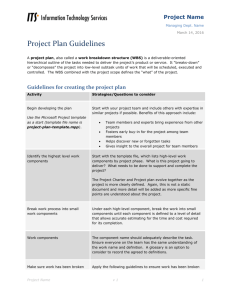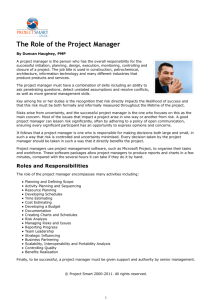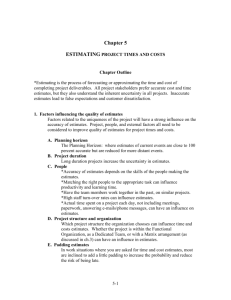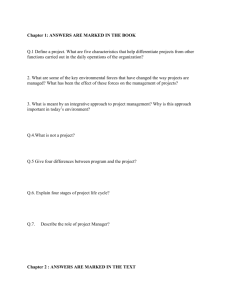Budgeting and Scheduling
advertisement
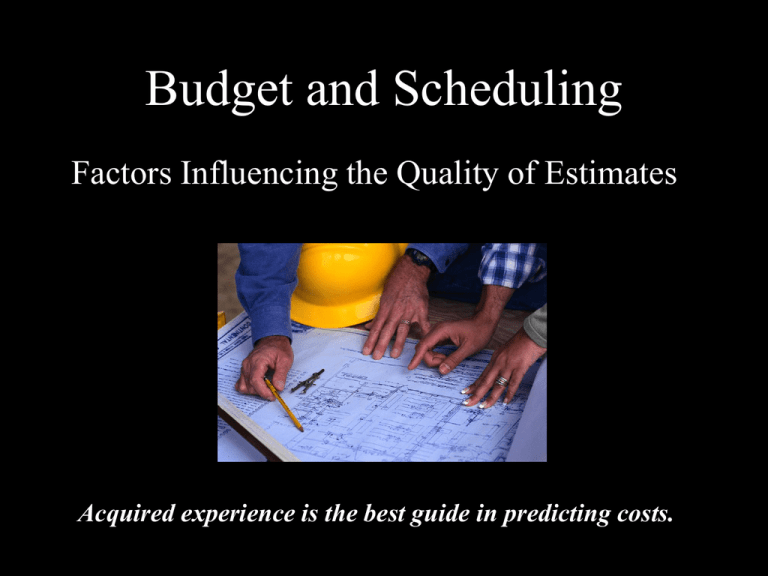
Budget and Scheduling Factors Influencing the Quality of Estimates Acquired experience is the best guide in predicting costs. Common Factors to Consider: Project Structure and Organization Which project structure is chosen to manage the project will influence time and cost estimates. • The advantages of a dedicated project team is the speed gained from concentrated focus and localized project decisions. • Projects operating in a matrix environment may reduce costs by efficiently sharing personnel across projects, but may take longer to complete since attention is divided and coordination demands are higher. Common Factors to Consider: The Planning Horizon Early stages of the planning process generate multiple hypotheticals and questions, but as the process is refined and project implementation draws near, nearly all issues should be resolved. • Estimates of current events are close to 100 percent accurate but are reduced for more distant events. • Accuracy of time and cost estimates should improve as you move from the conceptual to the point where individual work packages are defined. Common Factors to Consider: Project Duration Time to implement new technology has a habit of expanding in an increasing, nonlinear fashion. • Poorly written scope specifications for new technology result in errors in estimating times and costs. • Long-duration projects increase the uncertainty in estimates. Common Factors to Consider: People Accuracy depends on the skills of the people making the estimates • A close match of people skills to the task will influence productivity and learning time. • Team members who have worked together before will influence the time it takes to form an effective team. • Increasing new people to a project increases time spent communicating. Common Factors to Consider: Padding Estimates Most of us are inclined to add a little padding to increase the probability of success and reduce the risk of being over budget. • If everyone at all levels of a project adds a little padding to reduce risk, the project duration and cost are seriously overstated. • In a competitive environment cost padding is counterproductive to gaining project acceptance. However… • As a project manager, it is prudent to calculate an overall safety margin of 10% to account for unexpected variations in project execution. Common Factors to Consider: Organizational Culture Organizational culture can significantly influence project estimates. • In some organizations padding estimates is tolerated and even privately encouraged. • Other organizations place a premium on accuracy and strongly discourage estimating gamesmanship. Common Factors to Consider: Other Factors Non-project factors can impact time and cost estimates. • • • • • • Equipment downtime Local and national holidays Vacations and sick leave Legal work limits Municipal and utility delays Contractual interruptions Estimating Project Time an Cost Detailed Estimates for the WBS Work Packages Probably the most reliable method for estimating time and cost is to use the WBS and to ask the people responsible for the work package to make the estimates. Estimate accuracy improves with more detailed planning. The extent of this improvement varies by type of project. As the project progresses through its life cycle and more information is available, the reliability of the estimates should improve. Detailed Planning—The Arguments • Arguments for: – Detailed estimates result in better low-cost efficient methods that can be utilized down the road. – We were burned once. We need a detailed estimate of every task by the people responsible. • Arguments against: – Rough order of magnitude is good enough. Detailed estimates wastes time and money. – The project is internal. We don’t need to worry about cost. – The uncertainty is so great, spending time and money on estimates is a waste. The more you know the more you can anticipate. Time-Phased Budgeting Cost estimates are not a budget For most sizable projects, money is dispensed as the project is implemented. A time-phased budget determines when the money must be available. Three elements must be known in order to establish a realistic budget: • • • Project duration Completion of a work breakdown structure Identification of individual work packages Work packages usually consist of: • • • Direct costs: labor, materials, equipment, etc. Project overhead costs: Salaries, space, storage, etc. General and administrative overhead costs: Advertising, accounting, and senior management Estimating Guidelines Poor estimates are a major contributor to projects that have failed. 1. Identify who is responsible The individual responsible for a work package should generate the estimate for that work package. 2. Use several people to estimate Find other people with similar experiences to generate comparative estimates. 3. Define your “normal” conditions Consider the prevalent work culture, availability of resources, seasonal considerations, etc. 4. Be consistent with time units All task time units need to be the same. Estimating Guidelines (continued) 5. 6. 7. Treat each project independent of other projects Although experience is a major influence, pay attention to the potential differences present in individual projects. Account for interaction costs Identify task dependencies and the time and coordination required for a smooth project execution. Add a risk assessment Identify the degree of risk so that stakeholders can consider alternative process decisions. Common Culprits of Project Difficulty • Conditions turn out to be not so “normal.” Availability of resources are often the first to go when conditions change. Having to bring in outside contractors/help introduces uncertainty. • Things just go wrong on the project. Design flaws, accidents, theft, personality conflicts, etc. • Abrupt change in project scope or plans. Unstable project scopes are a major source of cost overruns. The farther into a project, the more costly the change. • Inaccurate assumptions Avoid making assumptions regarding cost and scheduling. Document your assumptions during the planning phase. • Once work gets behind, it tends to stay behind. If times represent average time, we should expect that 50 percent will be less than the estimate and 50 percent will exceed the estimate. Quality time and cost estimates are the bedrock of project control. Past experience is the best starting point for these estimates. Elements of a Budget • Time Plays an important role in determining the need for funds availability. • Direct Costs Determines the costs for the “nuts and bolts” of a specific project. • Indirect Costs Determined by the business environment, working conditions, etc. Defining Direct and Indirect Costs Direct Costs: Those costs (labor, material, equipment, etc.) that can be consistently related to work performed on a particular project. Direct costs are best contrasted with indirect costs that cannot be identified to a specific project. Examples: Labor, equipment, materials, etc. Indirect Costs: Expenses that have been incurred by the operation in general, but which cannot be identified and charged directly to a specific project without an inordinate amount of tracking and accounting. Often referred to as overhead. Examples: Electricity, water, sewer, bookkeeping, etc. Direct Costs Count Position Hours Hourly Rate Amount 1 Vice-President of Instruction 12 48 576.00 1 Director of Assessment 49 39 1,911.00 1 Project Manager 202 32 6,464.00 1 DB Administrator 180 32 5,760.00 1 Programmer 358 27 9,666.00 19 340 6,460.00 10 Department Chairs Total: 820 30,837.00 Indirect Costs Category Amount Administration and clerical salaries and fringe @ $21/hr Total hours: 812 17,052 General office supplies 1,980 Computer supplies and general-purpose software 1,200 Postage and delivery charges 200 Telephone charges 150 Printing production and photocopying 150 Total Indirect Costs $ 20,732 Per hour indirect costs: $25.53 Example Time-Phased Budget • Time-Phased Budget Establishes the specific allocation of resources, time and cost throughout the duration of the project. Potter - WBS and Budget.xls Questions?? Comments??

